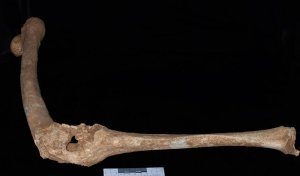
The famous “Tomb of Philip” is not after all the tomb in which the remains of the legendary king Philip II of Macedon, father of Alexander the Great, were laid to rest. Another adjacent well-known tomb is, however, the actual tomb in which his remains were found.
These are the results of a study, published in the Proceedings of the National Academy of Sciences (PNAS), of skeletal remains found in what has been designated ‘Tomb I’ within the Great Tumulus hill located near the northern Greek town of Vergina in Macedonia. Led by Antonis Bartsiokas of the Democritus University of Thrace and Juan-Luis Arsuaga of the Centro Mixto Universidad Complutense de Madrid, a team of researchers, using state-of-the-art scanning and radiography techniques and equipment, closely examined a partial skeleton that had been long disinterred from the first (‘Tomb 1’) of three royal tombs of the Vergina Tumulus.
Some scholarly wisdom has held that the second of the 3 tombs (‘Tomb 2’), commonly called the “Tomb of Philip,” contained the remains of King Philip II. This was based on several lines of evidence previously advanced by the University of Bristol anatomist Jonathan Musgrave, along with British archaeologist John Prag and medical illustrator Richard Neave, both of the University of Manchester. The skeleton that was found in that two-chambered royal tomb in 1977 was that of a man 35 to 55 years old at the time of death (Philip died at 46), exhibited signs of battle wounds, and was placed in a golden larnax (or chest), which bore an embossed starburst, the emblem of the Macedonian royal family. Also associated with that skeleton were an iron helmet, a ceremonial shield, an iron and gold cuirass, a gilded silver diadem, and two ivory head portraits interpreted to be those of Philip II and Alexander. In addition, the remains of a woman, interpreted to be that of Cleopatra, Philip’s wife at his death, were found in the tomb’s second chamber.
But further research suggested that the royal artifacts found in the tomb were more likely dated to about 317 B.C., long after Philip’s assassination in 336 B.C., and a later study of the skeleton by Bartsiokas using macrophotography techniques suggested that the skeletal evidence proposed to support the identification were actually unusual anatomical characteristics that were affected by cremation and insufficient reconstruction of the remains. In addition, the remains did not bear some of the characteristic evidence of wounds widely known from the literature to have been associated with the warrior king—particularly a lance wound he sustained in battle in his leg, which crippled the monarch three years before he was slain in 336 BCE.
The skeleton found in Tomb 1, however, seemed to match the description. Strikingly tall at around 180 cms, the approximately 45-year-old male in Tomb 1 had leg bones with a knee joint showing the clear signs of fusion (ankylosis), and a hole through the knee overgrowth indicative of a piercing wound “likely affected by a penetrating instrument, such as a fast-moving projectile (like a spear).”*. Also noted were signs of trauma-related inflammation, and asymmetrical bone lesions that suggest wryneck, a plausible side effect of compensatory head tilting tied to uneven gait.
_________________________________________
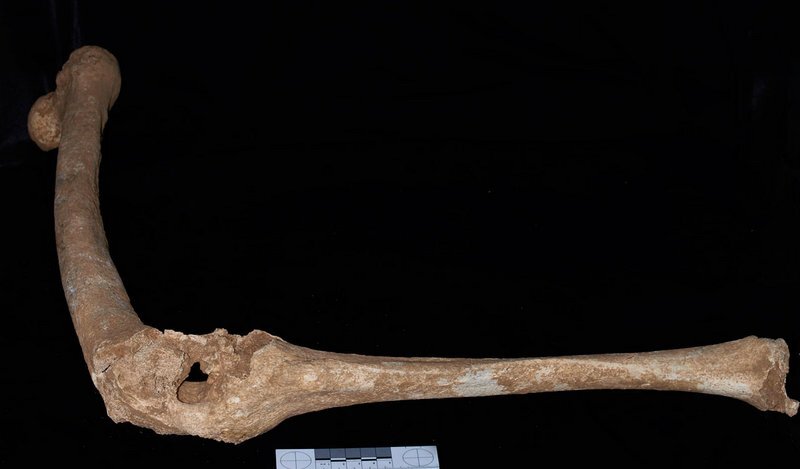 Left leg of King Philip II of Macedonia showing the massive knee ankylosis (fusion of the joint). Image courtesy of Javier Trueba.
Left leg of King Philip II of Macedonia showing the massive knee ankylosis (fusion of the joint). Image courtesy of Javier Trueba.
_________________________________________
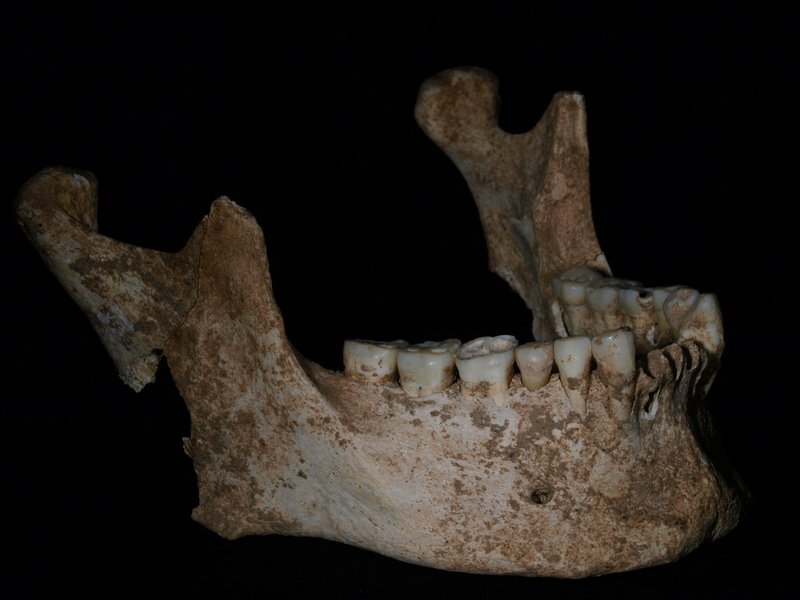 Mandible of King Philip II of Macedonia. Image courtesy of Javier Trueba.
Mandible of King Philip II of Macedonia. Image courtesy of Javier Trueba.
_______________________________________________________
 Portrait of King Philip II of Macedonia in his late years, after having received a wound through his left leg by a lance. Image courtesy of Arturo Asensio.
Portrait of King Philip II of Macedonia in his late years, after having received a wound through his left leg by a lance. Image courtesy of Arturo Asensio.
___________________________________________________________
Moreover, Tomb 1 also contained the remains of an estimated 18-year-old female and an approximately 42 week-old infant of unknown gender, the combination of which supports a grim story: According to the writings of Diodorus, Olympias, the fourth wife of Philip and mother to Alexander, murdered Cleopatra and her baby soon after Philip’s assassination and her son Alexander’s ascendance to the throne. According to Justin, Olympias also burned the body of Philip’s assassin, Pausanias, a few days after Philip’s death, and then forced Cleopatra to hang herself, having first killed her daughter.
____________________________________________
 Maxilla of Queen Cleopatra, wife of King Philip II of Macedonia. Image courtesy of Javier Trueba.
Maxilla of Queen Cleopatra, wife of King Philip II of Macedonia. Image courtesy of Javier Trueba.
______________________________________________________
 Legs of Queen Cleopatra, wife of King Philip II of Macedonia. Image courtesy of Antonis Bartsiokas.
Legs of Queen Cleopatra, wife of King Philip II of Macedonia. Image courtesy of Antonis Bartsiokas.
________________________________________________________
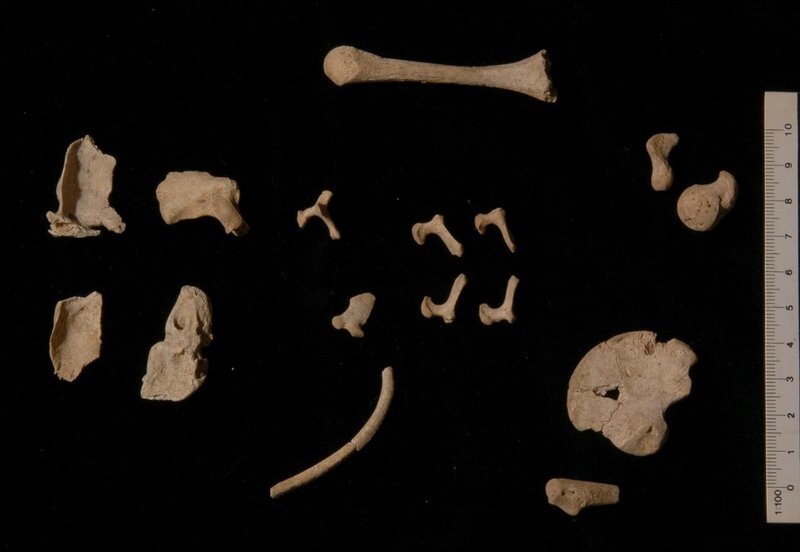 Bones of newborn child of Queen Cleopatra and King Philip II of Macedonia. Image courtesy of Antonis Bartsiokas.
Bones of newborn child of Queen Cleopatra and King Philip II of Macedonia. Image courtesy of Antonis Bartsiokas.
______________________________________________________
The authors suggest that Tomb 1 contains the mortal remains of Philip II as well as his wife Cleopatra and his child. Hence, the authors reason, Tomb 2 must contain the remains of King Arrhidaeus, one of King Philip’s sons, and his wife Eurydice.
______________________________________________________
*Bartsiokas, et al., The lameness of King Philip II and Royal Tomb I at Vergina, Macedonia, Proceedings of the National Academy of Sciences, www.pnas.org/cgi/doi/10.1073/pnas.1510906112.
Some content has been edited and adapted from a related PNAS press release.
______________________________________________________
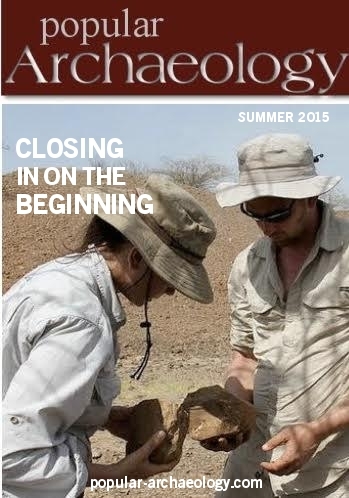 Read more in-depth articles about archaeology with a premium subscription to Popular Archaeology Magazine.
Read more in-depth articles about archaeology with a premium subscription to Popular Archaeology Magazine.
In addition, the latest Popular Archaeology ebook is now available.
______________________________________________
Travel and learn with Far Horizons.
____________________________________________
 Popular Archaeology’s annual Discovery Edition eBook is a selection of the best stories published in Popular Archaeology Magazine in past issues, with an emphasis on some of the most significant, groundbreaking, or fascinating discoveries in the fields of archaeology and paleoanthropology and related fields. At least some of the articles have been updated or revised specifically for the Discovery edition. We can confidently say that there is no other single issue of an archaeology-related magazine, paper print or online, that contains as much major feature article content as this one. The latest issue, volume 2, has just been released. Go to the Discovery edition page for more information.
Popular Archaeology’s annual Discovery Edition eBook is a selection of the best stories published in Popular Archaeology Magazine in past issues, with an emphasis on some of the most significant, groundbreaking, or fascinating discoveries in the fields of archaeology and paleoanthropology and related fields. At least some of the articles have been updated or revised specifically for the Discovery edition. We can confidently say that there is no other single issue of an archaeology-related magazine, paper print or online, that contains as much major feature article content as this one. The latest issue, volume 2, has just been released. Go to the Discovery edition page for more information.
____________________________________________






